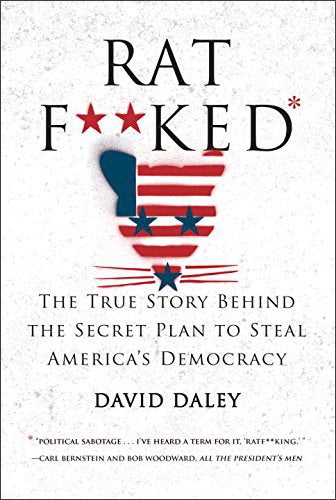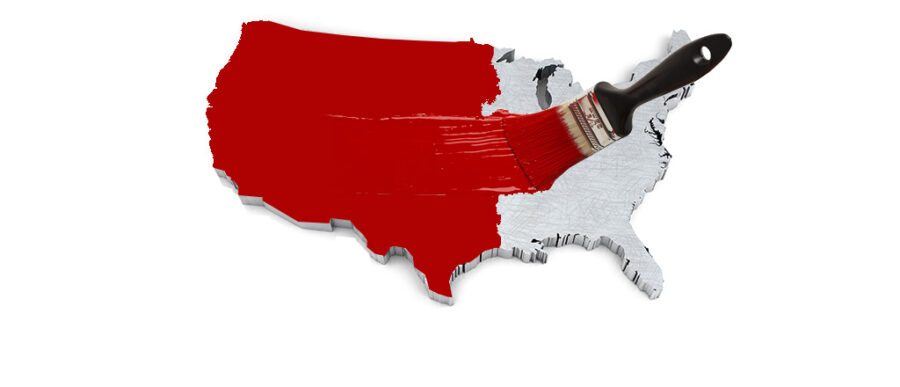 The business of running the country changed with the 2010 elections, according to a new book by Salon Editor-in-Chief David Daley. Well-planned, carefully constructed strategies that changed the boundaries of several key voting districts helped the Republican party gain control of Congress. Daley stopped by the Knowledge at Wharton Show on SiriusXM channel 111 to talk about the book, Ratf**ked: The True Story Behind the Secret Plan to Steal America’s Democracy.
The business of running the country changed with the 2010 elections, according to a new book by Salon Editor-in-Chief David Daley. Well-planned, carefully constructed strategies that changed the boundaries of several key voting districts helped the Republican party gain control of Congress. Daley stopped by the Knowledge at Wharton Show on SiriusXM channel 111 to talk about the book, Ratf**ked: The True Story Behind the Secret Plan to Steal America’s Democracy.
Knowledge at Wharton: Gerrymandering, the subject of your book, is a process a lot of people may not understand. It starts at the local level, which affects the state level, and the state level affects the national level.
David Daley: That’s exactly right. It’s a long process. Essentially what happens is, every 10 years the Constitution mandates a re-drawing of all state legislative and congressional districts after the census. The census is taken in years that end in zero, so elections that take place in years ending in zero mean more. They reverberate throughout the course of the next decade.
What’s kind of amazing is that gerrymandering has been going on for as long as we’ve had a republic. You can trace it back to 1790 and Gov. Elbridge Gerry in Massachusetts. That’s where it gets its name. It has been the source of all sorts of political chicanery and incumbent protection, or shifting a line to try and get back at a political enemy, for years. Both sides have done it.
What happened in 2010 and in 2011, however, is completely different from any other redistricting in our history. In part, because [conservative nonprofit group] Citizens United unleashes a flood of dark money into the system that allows the Republican Party to devise and execute a brilliant plan and a big political bargain. They go out and spend $30 million on local races in 2010 with the express design of trying to flip state legislative chambers in states where they’d be able to maximize control of redistricting that following year — in Pennsylvania, Michigan, Ohio, Wisconsin, North Carolina, Florida, Texas, New York. They target local races with big national dollars. The technology of mapping has gotten so much better thanks to computers that it is exact and precise in a way it never has been before. There’s so much information about us that you can add on to this program called Maptitude, which is what legislators and strategists use to draw these lines. You can add on not only all the census information, all the public voting records, but you can go out and buy all the private data sets that are available based on the information that we give up freely to marketers online every single day. This wasn’t even available in 2000 or 1990 to this extent. So, what happens in 2010 is unheard of. It’s a really well thought out and well executed plan. And it’s had far-reaching consequences.
“… Elections that take place in years ending in zero mean more. They reverberate throughout the course of the next decade.”
Knowledge at Wharton: What is dark money?
Daley: This is political money that is contributed to a political action group, and you can’t trace the source of it back. It’s essentially anonymous money, and that’s what makes it dangerous. The campaign finance reforms of the 1970s after Watergate were designed to at least have transparency so that you would know where the money was coming from. In 2010, the Supreme Court rules in the Citizens United vs. FEC case that that’s unconstitutional. Corporations can spend unlimited amounts, and it does not all have to be explained away or made clear where that money is coming from.
Knowledge at Wharton: You write about how tiny Westmoreland County, just to the east of Pittsburgh, was an important area in the state of Pennsylvania.
Daley: It was. If you go back to 2010, the Democrats held a really small edge in the state legislature. When the Republicans who designed this plan, called REDMAP, tried to figure out which districts to target in order to try and flip the legislature that fall, one of them was a seat belonging to a 13-term legislator named David Levdansky, who ran the finance committee in Harrisburg. He was one of the people they took down with a really aggressive three-week negative ad barrage. It was hundreds of thousands of dollars at the very end of a campaign that he just never saw coming.
The Republicans were able to take control of the House in 2010. They had the Senate. Tom Corbett gets elected governor of Pennsylvania. Those are the three prongs of redistricting: the legislature, the Senate and the governor. If you control all three pieces, you can pretty much do whatever you want with those lines without the other party having any say at all. So, the Republicans re-draw the lines in Pennsylvania, and the first election that is conducted on those lines is in 2012. Now, 2012 is a big Democratic year. Barack Obama is re-elected president with 332 electoral votes. He carries the state of Pennsylvania by several hundred thousand votes. A total of 100,000 more voters cast their ballots for Democratic House candidates than Republican candidates in the aggregate. Yet the end result of this is that 13 Republicans are elected to Congress and five Democrats. That means 51% of the vote equates to 28% of the seats in Pennsylvania.
Knowledge at Wharton: What was the response by the Democratic Party? Did they not see this coming?
Daley: They didn’t see it coming, but it’s a catastrophic strategic failure on the part of the Democratic Party. In some ways, this idea could have been sitting out there for anyone to do.
Knowledge at Wharton: If we’re talking about every 10 years when the census comes about, let’s play this out. The year 2020 is not only going to be an election year, it will be a presidential election year.
Daley: It could conceivably be better for the Democrats because they tend to see better turnout in presidential years than they do in off-years. However, this is a state and a local issue as well as a big level. The Democrats don’t simply have to take back Congress in order to change this system. They have to win back legislative districts and legislative chambers across the country. And they have to do this on the maps that the Republicans drew. The system is locked and knotted up in really complicated ways at a variety of levels. It’s going to be really, really hard for the Democrats to undo this.
“Gerrymandering has been going on for as long as we’ve had a republic…. It has been the source of all kinds of political chicanery.”
Knowledge at Wharton: Was there anything illegal in all of these moves at the local and state levels?
Daley: Gerrymandering is not illegal. No. I would say that whenever courts have gotten a look at these districts, they have been frustrated by them. But it’s not that the strategists involved did anything illegal at the national level. However, in North Carolina there was a case involving the racial fairness of these lines. A court mandated that some of them be re-drawn.
Florida might be the most interesting case. In 2010, the voters in Florida pass something called a fair district referendum, in which voters of the state say, “We want redistricting taken out of the hands of politicians, and we want it to be a fair and open and transparent process.” It did not work that way. The Republicans who were in charge of the state — some of the legislative leaders and some of the top strategists in the state — essentially conducted a shadow redistricting process and filtered the maps through citizens in order to get them introduced before the legislature. One of the most scathing legal opinions I have seen on gerrymandering was brought down by a Florida Supreme Court judge in 2014. He ordered a whole bunch of those districts re-drawn.
Knowledge at Wharton: You talk about a couple of key figures that were involved in this process. One that a lot of people know is Karl Rove, but one that a lot of people probably don’t know is Chris Jankowski. Explain his role and how this all came about.
“The system is locked and knotted up in really complicated ways at a variety of levels.”
Daley: Jankowski is one of the most brilliant Republican strategists of his generation. The fact that he’s not known is amazing because by coming up with this plan, he essentially gives his party control of Congress for a decade at the bargain-basement price of $30 million. You can’t even run a losing Senate campaign these days for $30 million, let alone locking in control of the House of Representatives for as long as he did.
Jankowski runs something called the Republican State Leadership Committee, along with Ed Gillespie, whom folks might remember from his days chairing the Republican National Committee and running for senator from Virginia. He has this eureka moment in 2009, not long after his party has been swept out in 2008. He’s reading a story in The New York Times on the elections that fall, and it looks ahead to 2010 and mentions it’s a redistricting year. Because he works with all these guys on the state level, it occurred to him, “How about if I get some money to people at the state level and try and take these states over? It’s is probably going to be a good year for us because in off-years, in mid-terms, things swing back the other way.” The party in control of the White House usually loses seats the following year. And 2010 ends up being a catastrophic year for the Democrats.
“These guys are using redistricting as partisan warfare.”
[Republicans] knew they’d have the wind at their back. They thought, “If we have some extra money and a strategy here, we can take advantage and maximize that wind and really have an impact on this before the next decade.” They also thought that if they took over state capitals, they’d be able to use those as a laboratory for conservative ideas and conservative governing over the course of the next decade, possibly even in blue and purple states. You see the results of this almost immediately in states like Wisconsin, Michigan and North Carolina that the Republicans were able to take over in 2010. The legislature shifts sharply to the right, and you end up seeing anti-labor legislation coming through in states, like Michigan, that have otherwise been a strong union state or a strong labor state. Same thing in Wisconsin, where collective-bargaining rights got removed from public teacher unions, or in North Carolina, where the transgender bathroom bill just passed even though polls show 60% of voters in North Carolina are opposed to it. The legislature is so conservative that it almost doesn’t matter. You end up with a strong shift to the right not only in the House of Representatives, but also in these legislative chambers in state capitals across the country.
Knowledge at Wharton: Let’s talk about North Carolina and what the key element was in that situation.
Daley: North Carolina is an amazing state. You have two key elements there, and one of them is what happened in the 1990s. In the 1990s, North Carolina essentially has a congressional delegation of 12, which tended to be about 8-4 Democratic. When [RNC counsel] Ben Ginsberg and [former RNC chairman] Lee Atwater pull off their plan to launch all of these majority-minority seats, it immediately turns the other direction. It turns 8-4 Republican. You see a couple of districts that are represented by African-Americans, and you pack all the Democratic votes into those districts. Then Republicans took the rest of the state.
In 2010, you see the second piece of this. There’s a guy named Art Pope, who is kind of the Koch Brothers of North Carolina. He works essentially with the Republican State Leadership Committee, and they come up with millions of dollars filtered through organizations called Real Jobs and a couple of other ones. They very aggressively target local Democratic legislators they think they can knock out. They replace them with Republicans, and they aggressively re-draw not only the maps of the statehouse and the state senate, but the congressional maps in such a way that it’s now 10-3 Republicans there.
“We are the only democracy in the world that allows politicians to draw their own lines and choose their own voters.”
The only thing they had to do in North Carolina was take over the legislature. The governor does not have a say in redistricting. If you control the legislature, you get to draw the lines 100%. They brought in a guy named Tom Hofeller, who is perhaps the most genius Republican mapmaker of all. Hofeller does a PowerPoint for legislators in which he talks about this as if redistricting is a training session for master super-spies in espionage instead of the folks who are creating the essential building blocks of our democracy. He gives them advice like, “Don’t fire the redistricting staff until you’re 100% everything is done. Don’t send any e-mails to anybody. Don’t talk to the press. Don’t leave your computer alone for a minute.”
These guys are using redistricting as partisan warfare. And they’ve got the tools and the technology to pull it off in a way that makes it more substantive and longer lasting than any other point in time.
Knowledge at Wharton: Many Americans feel that politicians have not done very much good service these days, no matter what side of the aisle they’re on. The expectation is that this is not going to change anytime soon.
Daley: I think you’re right about that, absolutely. We are the only democracy in the world that allows politicians to draw their own lines and choose their own voters. If we want the system to work better, you can’t let the folks we shouldn’t be trusting with it have control of the pens. Or in this case, the really powerful computer programs that allow them to essentially insulate themselves from the voters’ will. I don’t think we should be trusting the Democratic Party either to try and find a way to reverse this. We’re going to have to take this back into our own hands.
There are states where there have been referendums on nonpartisan redistricting to try to get this out of the hands of the politicians. It doesn’t matter if it’s a blue state or a red state. If it’s Florida, if it’s Arizona, if it’s Ohio, if it’s California, it passes. People want to do this. I think we all understand how broken this system is, and that we have to find a way to fix it. It’s going to come down to us.



